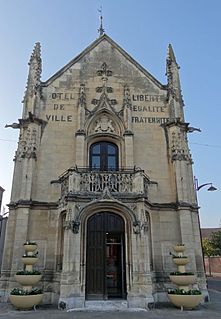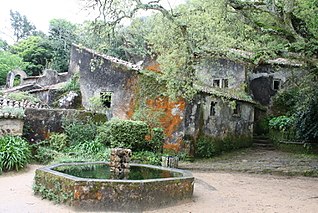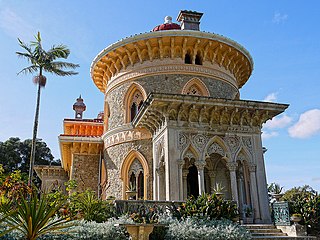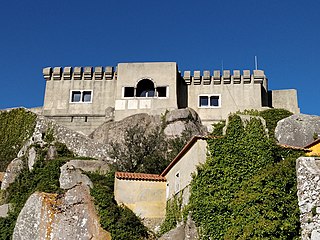
The Convention of Cintra was an agreement signed on 30 August 1808, during the Peninsular War. By the agreement, the defeated French were allowed to evacuate their troops from Portugal without further conflict. The Convention was signed at the Palace of Queluz, in Queluz, Cintra, Estremadura.

Sintra is a town and municipality in the Greater Lisbon region of Portugal, located on the Portuguese Riviera. The population of the municipality in 2011 was 377,835, in an area of 319.23 square kilometres (123.26 sq mi). Sintra is a major tourist destination in Portugal, famed for its picturesqueness and for its historic palaces and castles.

Cascais is a municipality in the Lisbon District of Portugal, located on the Portuguese Riviera. The population in 2011 was 206,479, in an area of 97.40 km2. Cascais is an important tourist destination. Its marina hosts events such as the America's Cup and the town of Estoril, part of the Cascais municipality, hosts conferences such as the Horasis Global Meeting.
Cintray may refer to communes in France:
Pedro de Sintra, also known as Pêro de Sintra, Pedro da Cintra and Pedro da Sintra, was a Portuguese explorer. He was among the first Europeans to explore the West African coast. Around 1462 his expedition reached what is now Sierra Leone and named it. Although according to professor C. Magbaily Fyle this could have possibly been a misinterpretation of historians; there has been evidence of Serra Lyoa being mentioned prior to 1462, the year when de Sintra's expedition reached the coast of Sierra Leone. This would suggest that the person who named Sierra Leone is still unknown. However, if de Sintra did name the area, it is unclear whether he named it after the landforms or climate in the area. According to some the coastal regions resembled lion's teeth while others suggest the thunderstorms sounded like the roar of a lion. Sixteenth century English sailors called the area Sierra Leoa which later evolved to Sierra Leone in the 17th century. The British, prior to the area being colonised, officially adopted the name Sierra Leone in 1787.

The Sintra Mountains, is a mountain range in western Portugal. Its highest point at is near Sintra. The range covers about 16 kilometers (10 mi) from the resort town of Sintra to Cabo da Roca(Cape Roca) on the Atlantic Ocean. It was known to the Ancient World as Lunae Mons and was the legendary retreat of Diana the Huntress.

The Pontifical Catholic University of São Paulo, locally known as PUC or the Catholic University, is a private and non-profit Catholic university. It is one of the largest and most prestigious universities of Brazil. It is maintained by the Catholic Archdiocese of São Paulo.

Municipium Cives Romanorum Felicitas Julia Olisipo was the ancient name of modern-day Lisbon while part of the Roman Empire.

Breteuil is a commune in the Eure department in Normandy in northern France. On 1 January 2016, the former communes Cintray and La Guéroulde were merged into Breteuil.

Cintray is a commune in the Eure-et-Loir department in northern France.

Neo-Manueline is a revival style of architecture which drew from the 16th century Manueline Late Gothic architecture of Portugal. Neo-Manueline constructions have been built across Portugal, Brazil, and the Lusofonia.
Sintra is both a town and a municipality in Portugal.
Gonçalo de Sintra or de Cintra (d.1444/45), was a 15th-century Portuguese explorer and slave raider.

The Convent of the Friars Minor Capuchin, popularly known as the Convent of the Capuchos, but officially the Convento de Santa Cruz da Serra da Sintra, is a historical convent consisting of small quarters and public spaces located in the civil parish of São Pedro de Penaferrim, in the municipality of Sintra. Its creation was associated with the Portuguese Viceroy of India, D. João de Castro, and his family, but became a pious community of reclusive clergy that continued to occupy cramp humble spaces in the complex, until the religious orders were abolished in Portugal.
The Fountain of Armés, alternatively called the Fountain of the Moors, is a 1st-century fountain built by Lucius Iulius Maelo Caudicus, an Olisipo flamen, to honour the Roman Emperor Augustus, in the village of Armés, civil parish of Tarregum in Sintra.

Portuguese art includes many different styles from many different eras.
The Sintra Natural History Museum is a museum of natural history located in the historic center of the village of Sintra. The museum has both at national and international level due to the quality and rarity of many of its exhibits.

The Castle of the Moors is a hilltop medieval castle located in the central Portuguese civil parish of Santa Maria e São Miguel, in the municipality of Sintra, about 25km northwest of Lisbon. Built by the Moors in the 8th and 9th centuries, it was an important strategic point during the Reconquista, and was taken by Christian forces after the fall of Lisbon in 1147. It is classified as a National Monument, part of the Sintra Cultural Landscape, a UNESCO World Heritage Site.

The Portuguese Riviera is the affluent coastal region to the west of Lisbon, Portugal, centered on the coastal cities of Cascais, Estoril, and Sintra. It is coterminous with the Estoril Coast and occasionally known as the Costa do Sol. The region is internationally known as a luxury destination for its history as a home of the wealthy, the famous, and European royalty.

The Sanctuary of Peninha is situated in the Sintra Mountains in the Sintra-Cascais Natural Park, in the Lisbon District of Portugal. It stands at an altitude of 448 metres on top of a rocky outcrop, which provides views over the coastline and inland areas. In addition to a baroque chapel, completed in 1710, the location contains the Palace of Peninha, which dates from 1918, as well as remains of a hermitage. The interiors of neither the chapel nor the palace can presently be visited.













